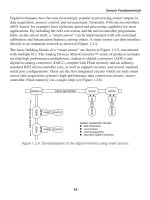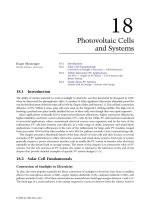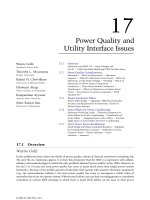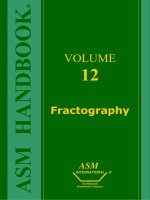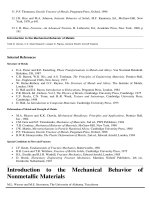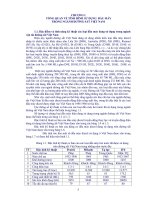Tài liệu Sensor Technology Handbook P1 ppt
Bạn đang xem bản rút gọn của tài liệu. Xem và tải ngay bản đầy đủ của tài liệu tại đây (633.48 KB, 30 trang )
TeAM
YYePG
Digitally signed by TeAM YYePG
DN: cn=TeAM YYePG, c=US,
o=TeAM YYePG, ou=TeAM YYePG,
email=
Reason: I attest to the accuracy and
integrity of this document
Date: 2005.05.31 00:16:46 +08'00'
Sensor Technology Handbook
This page intentionally left blank
Sensor Technology Handbook
Editor-in-Chief
Jon S. Wilson
AMSTERDAM • BOSTON • HEIDELBERG • LONDON
NEW YORK • OXFORD • PARIS • SAN DIEGO
SAN FRANCISCO • SINGAPORE • SYDNEY • TOKYO
Newnes is an imprint of Elsevier
Newnes is an imprint of Elsevier
30 Corporate Drive, Suite 400, Burlington, MA 01803, USA
Linacre House, Jordan Hill, Oxford OX2 8DP, UK
Copyright © 2005, Elsevier Inc. All rights reserved.
No part of this publication may be reproduced, stored in a retrieval
system, or transmitted in any form or by any means, electronic,
mechanical, photocopying, recording, or otherwise, without the prior
written permission of the publisher.
Permissions may be sought directly from Elsevier’s Science & Technology
Rights Department in Oxford, UK: phone: (+44) 1865 843830, fax: (+44)
1865 853333, e-mail: You may also com-
plete your request on-line via the Elsevier homepage (),
by selecting “Customer Support” and then “Obtaining Permissions.”
Recognizing the importance of preserving what has been written,
Elsevier prints its books on acid-free paper whenever possible.
Library of Congress Cataloging-in-Publication Data
(Application submitted.)
British Library Cataloguing-in-Publication Data
A catalogue record for this book is available from the British Library.
ISBN: 0-7506-7729-5
For information on all Newnes publications visit our Web site at:
www.books.elsevier.com
04 05 06 07 08 09 10 9 8 7 6 5 4 3 2 1
Printed in the United States of America
Preface .......................................................................................................................ix
CHAPTER 1: Sensor Fundamentals ............................................................................1
1.1 Basic Sensor Technology ................................................................................................ 1
1.2 Sensor Systems ............................................................................................................ 15
CHAPTER 2: Application Considerations ................................................................21
2.1 Sensor Characteristics .................................................................................................. 22
2.2 System Characteristics ................................................................................................. 22
2.3 Instrument Selection .................................................................................................... 23
2.4 Data Acquisition and Readout .....................................................................................26
2.5 Installation ..................................................................................................................26
CHAPTER 3: Measurement Issues and Criteria .......................................................29
CHAPTER 4: Sensor Signal Conditioning ................................................................ 31
4.1 Conditioning Bridge Circuits ....................................................................................... 31
4.2 Amplifiers for Signal Conditioning ............................................................................... 45
4.3 Analog to Digital Converters for Signal Conditioning ................................................... 92
4.4 Signal Conditioning High Impedance Sensors ........................................................... 108
CHAPTER 5: Acceleration, Shock and Vibration Sensors .....................................137
5.1 Introduction .............................................................................................................. 137
5.2 Technology Fundamentals ........................................................................................ 137
5.3 Selecting and Specifying Accelerometers ................................................................... 150
5.4 Applicable Standards ............................................................................................... 153
5.5 Interfacing and Designs ............................................................................................. 155
CHAPTER 6: Biosensors ..........................................................................................161
6.1 Overview: What Is a Biosensor? ................................................................................. 161
6.2 Applications of Biosensors ......................................................................................... 164
6.3 Origin of Biosensors .................................................................................................. 168
6.4 Bioreceptor Molecules ............................................................................................... 169
6.5 Transduction Mechanisms in Biosensors ..................................................................... 171
6.6 Application Range of Biosensors ................................................................................ 173
6.7 Future Prospects ........................................................................................................ 177
v
Contents
vi
Contents
CHAPTER 7: Chemical Sensors ...............................................................................181
7.1 Technology Fundamentals ......................................................................................... 181
7.2 Applications .............................................................................................................. 188
CHAPTER 8: Capacitive and Inductive Displacement Sensors .............................193
8.1 Introduction .............................................................................................................. 193
8.2 Capacitive Sensors ..................................................................................................... 194
8.3 Inductive Sensors ....................................................................................................... 196
8.4 Capacitive and Inductive Sensor Types ....................................................................... 198
8.5 Selecting and Specifying Capacitive and Inductive Sensors ......................................... 200
8.6 Comparing Capacitive and Inductive Sensors ............................................................. 203
8.7 Applications .............................................................................................................. 204
8.8 Latest Developments ................................................................................................. 221
8.9 Conclusion ................................................................................................................ 222
CHAPTER 9: Electromagnetism in Sensing ........................................................... 223
9.1 Introduction .............................................................................................................. 223
9.2 Electromagnetism and Inductance ............................................................................. 223
9.3 Sensor Applications ................................................................................................... 226
9.4 Magnetic Field Sensors .............................................................................................. 232
9.5 Summary ................................................................................................................... 235
CHAPTER 10: Flow and Level Sensors ...................................................................237
10.1 Methods for Measuring Flow ................................................................................... 237
10.2 Selecting Flow Sensors ............................................................................................ 246
10.3 Installation and Maintenance ................................................................................... 247
10.4 Recent Advances in Flow Sensors ............................................................................ 249
10.5 Level Sensors ........................................................................................................... 250
10.6 Applicable Standards ............................................................................................... 254
CHAPTER 11: Force, Load and Weight Sensors ....................................................255
11.1 Introduction ............................................................................................................ 255
11.2 Quartz Sensors ........................................................................................................ 255
11.3 Strain Gage Sensors ................................................................................................ 262
CHAPTER 12: Humidity Sensors ............................................................................271
12.1 Humidity ................................................................................................................. 271
12.2 Sensor Types and Technologies ................................................................................ 271
12.3 Selecting and Specifying Humidity Sensors .............................................................. 275
12.4 Applicable Standards ............................................................................................... 279
12.5 Interfacing and Design Information ......................................................................... 280
CHAPTER 13: Machinery Vibration Monitoring Sensors .....................................285
13.1 Introduction ............................................................................................................ 285
13.2 Technology Fundamentals ....................................................................................... 288
13.3 Accelerometer Types ................................................................................................ 291
13.4 Selecting Industrial Accelerometers .......................................................................... 294
13.5 Applicable Standards ............................................................................................... 303
vii
Contents
13.6 Latest and Future Developments .............................................................................. 304
13.7 Sensor Manufacturers .............................................................................................. 304
13.8 References and Resources ........................................................................................ 305
CHAPTER 14: Optical and Radiation Sensors .......................................................307
14.1 Photosensors ........................................................................................................... 307
14.2 Thermal Infrared Detectors ...................................................................................... 317
CHAPTER 15: Position and Motion Sensors ..........................................................321
15.1 Contact and Non-contact Position Sensors .............................................................. 321
15.2 String Potentiometer and String Encoder Engineering Guide .................................... 370
15.3 Linear and Rotary Position and Motion Sensors ........................................................ 379
15.4 Selecting Position and Displacement Transducers ..................................................... 401
CHAPTER 16: Pressure Sensors ..............................................................................411
16.1 Piezoresistive Pressure Sensing ................................................................................. 411
16.2 Piezoelectric Pressure Sensors
....................................................................433
CHAPTER 17: Sensors for Mechanical Shock ........................................................457
17.1 Technology Fundamentals ....................................................................................... 457
17.2 Sensor Types, Advantages and Disadvantages .......................................................... 459
17.3 Selecting and Specifying .......................................................................................... 461
17.4 Applicable Standards ............................................................................................... 473
17.5 Interfacing Information ............................................................................................ 474
17.6 Design Techniques and Tips, with Examples ............................................................. 478
17.7 Latest and Future Developments .............................................................................. 480
CHAPTER 18: Test and Measurement Microphones ............................................481
18.1 Measurement Microphone Characteristics ............................................................... 481
18.3 Traditional Condenser Microphone Design ............................................................... 483
18.4 Prepolarized (or Electret) Microphone Design ........................................................... 484
18.5 Frequency Response ................................................................................................ 484
18.6 Limitations on Measurement Range ......................................................................... 490
18.7 Effect of Environmental Conditions .......................................................................... 491
18.8 Microphone Standards ............................................................................................ 492
18.9 Specialized Microphone Types .................................................................................. 494
18.10 Calibration ............................................................................................................ 497
18.11 Major Manufacturers of Test and Measurement Microphones ................................ 499
CHAPTER 19: Strain Gages .....................................................................................501
19.1 Introduction to Strain Gages .................................................................................... 501
19.2 Strain-Gage Based Measurements ........................................................................... 511
19.3 Strain Gage Sensor Installations ............................................................................... 522
CHAPTER 20: Temperature Sensors ......................................................................531
20.1 Sensor Types and Technologies ................................................................................ 531
20.2 Selecting and Specifying Temperature Sensors ......................................................... 535
viii
CHAPTER 21: Nanotechnology-Enabled Sensors .................................................563
21.1 Possibilities .............................................................................................................. 564
21.2 Realities ................................................................................................................... 566
21.3 Applications ............................................................................................................ 567
23.4 Summary ................................................................................................................. 571
CHAPTER 22: Wireless Sensor Networks: Principles and Applications ...............575
22.1 Introduction to Wireless Sensor Networks ................................................................ 575
22.2 Individual Wireless Sensor Node Architecture ........................................................... 576
22.3 Wireless Sensor Networks Architecture .................................................................... 577
22.4 Radio Options for the Physical Layer inWireless Sensor Networks ............................. 580
22.5 Power Consideration in Wireless Sensor Networks ................................................... 583
22.6 Applications of Wireless Sensor Networks ....................................................... 585
22.7 Future Developments ............................................................................................... 588
APPENDIX A: Lifetime Cost of Sensor Ownership ...............................................591
APPENDIX B: Smart Sensors and TEDS FAQ .........................................................597
APPENDIX C: Units and Conversions ....................................................................601
APPENDIX D: Physical Constants ...........................................................................607
APPENDIX E: Dielectric Constants .........................................................................615
APPENDIX F: Index of Refraction .......................................................................... 617
APPENDIX G: Engineering Material Properties ....................................................619
APPENDIX H: Emissions Resistivity ....................................................................... 625
APPENDIX I: Physical Properties of Some Typical Liquids ...................................629
APPENDIX J: Speed of Sound in Various Bulk Media ..........................................631
APPENDIX K: Batteries ...........................................................................................633
APPENDIX L: Temperatures ...................................................................................635
Contributor’s Biographies .....................................................................................
637
Contributing Companies .......................................................................................647
Sensor Suppliers .....................................................................................................655
Subject Index ..........................................................................................................683
Sensor Technology Index ......................................................................................
690
Contents
ix
Preface
The first decade of the 21
st
century has been labeled by some as the “Sensor Decade.”
With a dramatic increase in sensor R&D and applications over the past 15 years, sen-
sors are certainly poised on the brink of a revolution similar to that experienced in
microcomputers in the 1980s. Just in automobiles alone, sensing needs are growing
by leaps and bounds, and the sensing technologies used are as varied as the applica-
tions. Tremendous advances have been made in sensor technology and many more are
on the horizon.
In this volume, we attempted to balance breadth and depth in a single, practical and
up-to-date resource. Understanding sensor design and operation typically requires a
cross-disciplinary background, as it draws from electrical engineering, mechanical
engineering, physics, chemistry, biology, etc. This reference pulls together the most
crucial information needed by those who design sensor systems and work with sen-
sors of all types, written by experts from industry and academia. While it would be
impossible to cover each and every sensor in use today, we attempted to provide as
broad a range of sensor types and applications as possible. The latest technologies,
from piezo materials to micro and nano sensors to wireless networks, are discussed,
as well as the tried and true methodologies. In addition, information on design, inter-
facing and signal conditioning is given for each sensor type.
Organized primarily by sensor application, the book is cross-referenced with indices
of sensor technology. Manufacturers are listed by sensor type. The other contributors
and I have attempted to provide a useful handbook with technical explanations that
are clear, simple and thorough. We will also attempt to keep it updated as the technol-
ogy advances.
Jon S. Wilson
Chandler, Arizona
October, 2004
This page intentionally left blank
